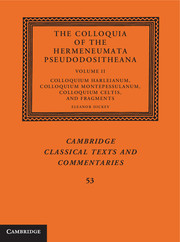Book contents
- Frontmatter
- Dedication
- Content
- List of plates page
- List of figures
- Acknowledgments
- Part One Colloquium Harleianum
- 1 Introduction to the Colloquium Harleianum
- TEXT, TRANSLATION, AND CRITICAL APPARATUS
- 2 Index Siglorum
- 3 Colloquium Harleianum
- Commentary
- 4 Commentary
- Part Two Colloquium Montepessulanum
- 5 Introduction to the Colloquium Montepessulanum
- Text, Translation, and Critical Apparatus
- 6 Index Siglorum
- 7 Colloquium Montepessulanum
- Commentary
- 8 Commentary
- Part Three Colloquium Celtis
- 9 Introduction to the Colloquium Celtis
- Text, Translation, and Critical Apparatus
- 10 Index Siglorum
- 11 Colloquium Celtis
- Commentary
- 12 Commentary
- Part Four Related texts
- 13 Editions of Papyri Connected to the Colloquium Tradition
- 14 The Berlin Trilingual Papyrus (P.Berol. INV. 10582): Reprinted Edition
- 15 Assorted Conversational Fragments(P.Berol. INV. 21860): New Edition
- 16 A Glossary Including Conversational Phrases (P.Lond. II.481): New Edition
- 17 A Glossary of Homonyms with Grammatical Information (P.Sorb. INV. 2069 Verso): Reprinted Edition
- 18 Grammatical Paradigms for Latin Learners (P.Louvre INV. E 7332): Reprinted Edition
- Endmatter
- References
- Indices to volumes I and II
- Index of notable Greek words and phrases
- Index of notable Latin words and phrases
- Index of topics mentioned in the colloquia
- Index of subjects discussed in the introduction and commentary
- References
References
Published online by Cambridge University Press: 25 November 2020
- Frontmatter
- Dedication
- Content
- List of plates page
- List of figures
- Acknowledgments
- Part One Colloquium Harleianum
- 1 Introduction to the Colloquium Harleianum
- TEXT, TRANSLATION, AND CRITICAL APPARATUS
- 2 Index Siglorum
- 3 Colloquium Harleianum
- Commentary
- 4 Commentary
- Part Two Colloquium Montepessulanum
- 5 Introduction to the Colloquium Montepessulanum
- Text, Translation, and Critical Apparatus
- 6 Index Siglorum
- 7 Colloquium Montepessulanum
- Commentary
- 8 Commentary
- Part Three Colloquium Celtis
- 9 Introduction to the Colloquium Celtis
- Text, Translation, and Critical Apparatus
- 10 Index Siglorum
- 11 Colloquium Celtis
- Commentary
- 12 Commentary
- Part Four Related texts
- 13 Editions of Papyri Connected to the Colloquium Tradition
- 14 The Berlin Trilingual Papyrus (P.Berol. INV. 10582): Reprinted Edition
- 15 Assorted Conversational Fragments(P.Berol. INV. 21860): New Edition
- 16 A Glossary Including Conversational Phrases (P.Lond. II.481): New Edition
- 17 A Glossary of Homonyms with Grammatical Information (P.Sorb. INV. 2069 Verso): Reprinted Edition
- 18 Grammatical Paradigms for Latin Learners (P.Louvre INV. E 7332): Reprinted Edition
- Endmatter
- References
- Indices to volumes I and II
- Index of notable Greek words and phrases
- Index of notable Latin words and phrases
- Index of topics mentioned in the colloquia
- Index of subjects discussed in the introduction and commentary
- References
- Type
- Chapter
- Information
- The Colloquia of the Hermeneumata Pseudodositheana , pp. 303 - 314Publisher: Cambridge University PressPrint publication year: 2015



